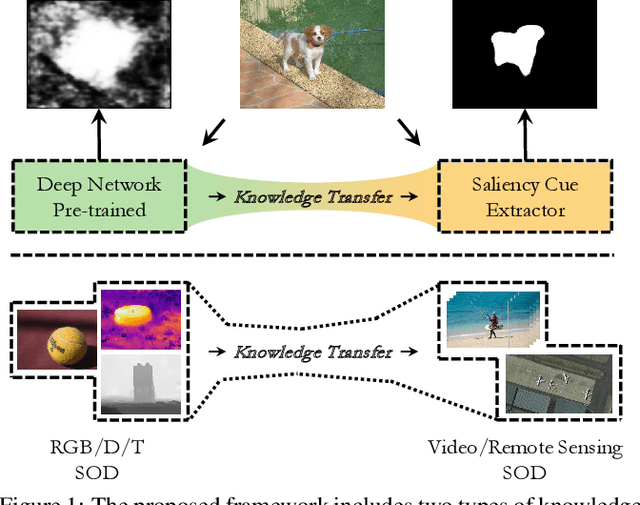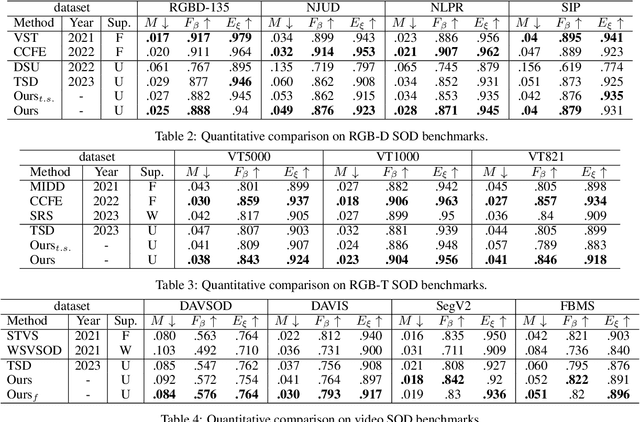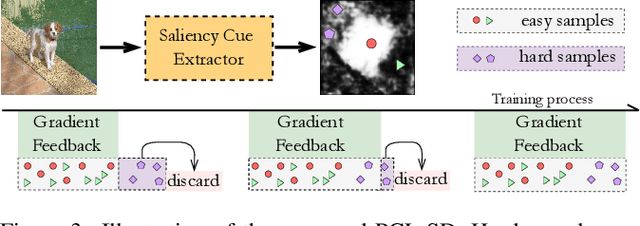Jie Qin
Uni4D: A Unified Self-Supervised Learning Framework for Point Cloud Videos
Apr 07, 2025Abstract:Point cloud video representation learning is primarily built upon the masking strategy in a self-supervised manner. However, the progress is slow due to several significant challenges: (1) existing methods learn the motion particularly with hand-crafted designs, leading to unsatisfactory motion patterns during pre-training which are non-transferable on fine-tuning scenarios. (2) previous Masked AutoEncoder (MAE) frameworks are limited in resolving the huge representation gap inherent in 4D data. In this study, we introduce the first self-disentangled MAE for learning discriminative 4D representations in the pre-training stage. To address the first challenge, we propose to model the motion representation in a latent space. The second issue is resolved by introducing the latent tokens along with the typical geometry tokens to disentangle high-level and low-level features during decoding. Extensive experiments on MSR-Action3D, NTU-RGBD, HOI4D, NvGesture, and SHREC'17 verify this self-disentangled learning framework. We demonstrate that it can boost the fine-tuning performance on all 4D tasks, which we term Uni4D. Our pre-trained model presents discriminative and meaningful 4D representations, particularly benefits processing long videos, as Uni4D gets $+3.8\%$ segmentation accuracy on HOI4D, significantly outperforming either self-supervised or fully-supervised methods after end-to-end fine-tuning.
UniViTAR: Unified Vision Transformer with Native Resolution
Apr 02, 2025Abstract:Conventional Vision Transformer simplifies visual modeling by standardizing input resolutions, often disregarding the variability of natural visual data and compromising spatial-contextual fidelity. While preliminary explorations have superficially investigated native resolution modeling, existing approaches still lack systematic analysis from a visual representation perspective. To bridge this gap, we introduce UniViTAR, a family of homogeneous vision foundation models tailored for unified visual modality and native resolution scenario in the era of multimodal. Our framework first conducts architectural upgrades to the vanilla paradigm by integrating multiple advanced components. Building upon these improvements, a progressive training paradigm is introduced, which strategically combines two core mechanisms: (1) resolution curriculum learning, transitioning from fixed-resolution pretraining to native resolution tuning, thereby leveraging ViT's inherent adaptability to variable-length sequences, and (2) visual modality adaptation via inter-batch image-video switching, which balances computational efficiency with enhanced temporal reasoning. In parallel, a hybrid training framework further synergizes sigmoid-based contrastive loss with feature distillation from a frozen teacher model, thereby accelerating early-stage convergence. Finally, trained exclusively on public datasets, externsive experiments across multiple model scales from 0.3B to 1B demonstrate its effectiveness.
WPS-SAM: Towards Weakly-Supervised Part Segmentation with Foundation Models
Jul 14, 2024



Abstract:Segmenting and recognizing diverse object parts is crucial in computer vision and robotics. Despite significant progress in object segmentation, part-level segmentation remains underexplored due to complex boundaries and scarce annotated data. To address this, we propose a novel Weakly-supervised Part Segmentation (WPS) setting and an approach called WPS-SAM, built on the large-scale pre-trained vision foundation model, Segment Anything Model (SAM). WPS-SAM is an end-to-end framework designed to extract prompt tokens directly from images and perform pixel-level segmentation of part regions. During its training phase, it only uses weakly supervised labels in the form of bounding boxes or points. Extensive experiments demonstrate that, through exploiting the rich knowledge embedded in pre-trained foundation models, WPS-SAM outperforms other segmentation models trained with pixel-level strong annotations. Specifically, WPS-SAM achieves 68.93% mIOU and 79.53% mACC on the PartImageNet dataset, surpassing state-of-the-art fully supervised methods by approximately 4% in terms of mIOU.
DSMix: Distortion-Induced Sensitivity Map Based Pre-training for No-Reference Image Quality Assessment
Jul 04, 2024Abstract:Image quality assessment (IQA) has long been a fundamental challenge in image understanding. In recent years, deep learning-based IQA methods have shown promising performance. However, the lack of large amounts of labeled data in the IQA field has hindered further advancements in these methods. This paper introduces DSMix, a novel data augmentation technique specifically designed for IQA tasks, aiming to overcome this limitation. DSMix leverages the distortion-induced sensitivity map (DSM) of an image as prior knowledge. It applies cut and mix operations to diverse categories of synthetic distorted images, assigning confidence scores to class labels based on the aforementioned prior knowledge. In the pre-training phase using DSMix-augmented data, knowledge distillation is employed to enhance the model's ability to extract semantic features. Experimental results on both synthetic and authentic IQA datasets demonstrate the significant predictive and generalization performance achieved by DSMix, without requiring fine-tuning of the full model. Code is available at \url{https://github.com/I2-Multimedia-Lab/DSMix}.
Puff-Net: Efficient Style Transfer with Pure Content and Style Feature Fusion Network
May 30, 2024Abstract:Style transfer aims to render an image with the artistic features of a style image, while maintaining the original structure. Various methods have been put forward for this task, but some challenges still exist. For instance, it is difficult for CNN-based methods to handle global information and long-range dependencies between input images, for which transformer-based methods have been proposed. Although transformers can better model the relationship between content and style images, they require high-cost hardware and time-consuming inference. To address these issues, we design a novel transformer model that includes only the encoder, thus significantly reducing the computational cost. In addition, we also find that existing style transfer methods may lead to images under-stylied or missing content. In order to achieve better stylization, we design a content feature extractor and a style feature extractor, based on which pure content and style images can be fed to the transformer. Finally, we propose a novel network termed Puff-Net, i.e., pure content and style feature fusion network. Through qualitative and quantitative experiments, we demonstrate the advantages of our model compared to state-of-the-art ones in the literature.
Cross-Domain Few-Shot Semantic Segmentation via Doubly Matching Transformation
May 24, 2024



Abstract:Cross-Domain Few-shot Semantic Segmentation (CD-FSS) aims to train generalized models that can segment classes from different domains with a few labeled images. Previous works have proven the effectiveness of feature transformation in addressing CD-FSS. However, they completely rely on support images for feature transformation, and repeatedly utilizing a few support images for each class may easily lead to overfitting and overlooking intra-class appearance differences. In this paper, we propose a Doubly Matching Transformation-based Network (DMTNet) to solve the above issue. Instead of completely relying on support images, we propose Self-Matching Transformation (SMT) to construct query-specific transformation matrices based on query images themselves to transform domain-specific query features into domain-agnostic ones. Calculating query-specific transformation matrices can prevent overfitting, especially for the meta-testing stage where only one or several images are used as support images to segment hundreds or thousands of images. After obtaining domain-agnostic features, we exploit a Dual Hypercorrelation Construction (DHC) module to explore the hypercorrelations between the query image with the foreground and background of the support image, based on which foreground and background prediction maps are generated and supervised, respectively, to enhance the segmentation result. In addition, we propose a Test-time Self-Finetuning (TSF) strategy to more accurately self-tune the query prediction in unseen domains. Extensive experiments on four popular datasets show that DMTNet achieves superior performance over state-of-the-art approaches. Code is available at https://github.com/ChenJiayi68/DMTNet.
Open-Vocabulary Spatio-Temporal Action Detection
May 17, 2024Abstract:Spatio-temporal action detection (STAD) is an important fine-grained video understanding task. Current methods require box and label supervision for all action classes in advance. However, in real-world applications, it is very likely to come across new action classes not seen in training because the action category space is large and hard to enumerate. Also, the cost of data annotation and model training for new classes is extremely high for traditional methods, as we need to perform detailed box annotations and re-train the whole network from scratch. In this paper, we propose a new challenging setting by performing open-vocabulary STAD to better mimic the situation of action detection in an open world. Open-vocabulary spatio-temporal action detection (OV-STAD) requires training a model on a limited set of base classes with box and label supervision, which is expected to yield good generalization performance on novel action classes. For OV-STAD, we build two benchmarks based on the existing STAD datasets and propose a simple but effective method based on pretrained video-language models (VLM). To better adapt the holistic VLM for the fine-grained action detection task, we carefully fine-tune it on the localized video region-text pairs. This customized fine-tuning endows the VLM with better motion understanding, thus contributing to a more accurate alignment between video regions and texts. Local region feature and global video feature fusion before alignment is adopted to further improve the action detection performance by providing global context. Our method achieves a promising performance on novel classes.
CDFormer:When Degradation Prediction Embraces Diffusion Model for Blind Image Super-Resolution
May 13, 2024



Abstract:Existing Blind image Super-Resolution (BSR) methods focus on estimating either kernel or degradation information, but have long overlooked the essential content details. In this paper, we propose a novel BSR approach, Content-aware Degradation-driven Transformer (CDFormer), to capture both degradation and content representations. However, low-resolution images cannot provide enough content details, and thus we introduce a diffusion-based module $CDFormer_{diff}$ to first learn Content Degradation Prior (CDP) in both low- and high-resolution images, and then approximate the real distribution given only low-resolution information. Moreover, we apply an adaptive SR network $CDFormer_{SR}$ that effectively utilizes CDP to refine features. Compared to previous diffusion-based SR methods, we treat the diffusion model as an estimator that can overcome the limitations of expensive sampling time and excessive diversity. Experiments show that CDFormer can outperform existing methods, establishing a new state-of-the-art performance on various benchmarks under blind settings. Codes and models will be available at \href{https://github.com/I2-Multimedia-Lab/CDFormer}{https://github.com/I2-Multimedia-Lab/CDFormer}.
Sparse Sampling is All You Need for Fast Wrong-way Cycling Detection in CCTV Videos
May 12, 2024



Abstract:In the field of transportation, it is of paramount importance to address and mitigate illegal actions committed by both motor and non-motor vehicles. Among those actions, wrong-way cycling (i.e., riding a bicycle or e-bike in the opposite direction of the designated traffic flow) poses significant risks to both cyclists and other road users. To this end, this paper formulates a problem of detecting wrong-way cycling ratios in CCTV videos. Specifically, we propose a sparse sampling method called WWC-Predictor to efficiently solve this problem, addressing the inefficiencies of direct tracking methods. Our approach leverages both detection-based information, which utilizes the information from bounding boxes, and orientation-based information, which provides insights into the image itself, to enhance instantaneous information capture capability. On our proposed benchmark dataset consisting of 35 minutes of video sequences and minute-level annotation, our method achieves an average error rate of a mere 1.475% while taking only 19.12% GPU time of straightforward tracking methods under the same detection model. This remarkable performance demonstrates the effectiveness of our approach in identifying and predicting instances of wrong-way cycling.
Unified Unsupervised Salient Object Detection via Knowledge Transfer
Apr 23, 2024



Abstract:Recently, unsupervised salient object detection (USOD) has gained increasing attention due to its annotation-free nature. However, current methods mainly focus on specific tasks such as RGB and RGB-D, neglecting the potential for task migration. In this paper, we propose a unified USOD framework for generic USOD tasks. Firstly, we propose a Progressive Curriculum Learning-based Saliency Distilling (PCL-SD) mechanism to extract saliency cues from a pre-trained deep network. This mechanism starts with easy samples and progressively moves towards harder ones, to avoid initial interference caused by hard samples. Afterwards, the obtained saliency cues are utilized to train a saliency detector, and we employ a Self-rectify Pseudo-label Refinement (SPR) mechanism to improve the quality of pseudo-labels. Finally, an adapter-tuning method is devised to transfer the acquired saliency knowledge, leveraging shared knowledge to attain superior transferring performance on the target tasks. Extensive experiments on five representative SOD tasks confirm the effectiveness and feasibility of our proposed method. Code and supplement materials are available at https://github.com/I2-Multimedia-Lab/A2S-v3.
 Add to Chrome
Add to Chrome Add to Firefox
Add to Firefox Add to Edge
Add to Edge